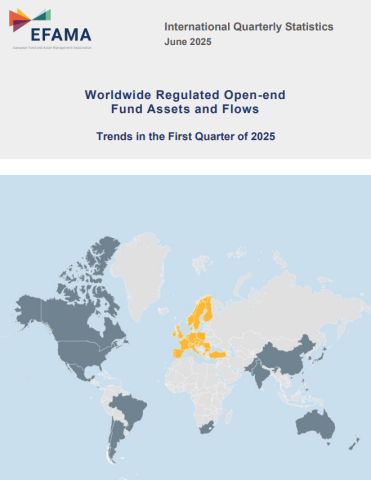Today, EFAMA has published its latest International Quarterly Statistical Release for Q1 2025.
Hailin Yang, Senior Data Analyst at EFAMA, commented on the Q1 2025 figures: “Across most regions, net fund sales slowed compared to Q4 2024, but remained generally positive. This occurred in a volatile and uncertain market environment, with investor sentiment negatively affected by geopolitical tensions and economic uncertainty.”
We show the following main developments in the worldwide investment fund industry for Q1 2025:
Net assets of worldwide investment funds decreased by 3.1% in euro terms.
The first quarter of 2025 saw a decline of 3.1% in net assets of worldwide investment funds to EUR 73.9 trillion. Measured in US dollar terms, net assets rose by 0.8% due to the depreciation of the US dollar vis-à-vis the euro.
Measured in local currency, net assets in the two largest fund markets, the United States and Europe, decreased by 0.8% and 1.2%, respectively.
Net sales of global long-term funds decreased in Q1 2025 but remained positive.
Worldwide long-term funds attracted net inflows of EUR 394 billion, a decline from EUR 702 billion in Q4 2024. Europe led with net sales of EUR183 billion, primarily driven by Ireland, which registered net inflows of EUR 80 billion. The United States followed with EUR 147 billion. The rest of the Americas registered net inflows of EUR 39 billion, with Canada contributing EUR 37 billion. The Asia-Pacific region registered modest net inflows of EUR 24 billion, compared to EUR 87 billion in Q4. Japan and the Republic of Korea recorded strong net inflows of EUR 34 billion and EUR 27 billion, respectively. China recorded significant net outflows of EUR 60 billion.
Equity funds registered net inflows of EUR 148 billion, down from EUR 353 billion in Q4 2024. Europe saw net inflows of EUR 64 billion, including EUR 56 billion from Ireland. The United States recorded net sales of EUR 26 billion, sharply lower than EUR 203 billion in Q4.
Bond funds attracted net inflows of EUR 214 billion, down from EUR 297 billion in Q4 2024. The United States recorded the largest inflows at EUR 156 billion, followed by Europe with EUR 77 billion, thanks to strong inflows in Luxembourg (EUR 21 billion), Ireland (EUR 17 billion), and France (EUR 12 billion). China saw net outflows of EUR 49 billion, reversing its Q4 inflows of EUR 24 billion.
Multi-asset funds continued their downward trend, posting net outflows of EUR 37 billion in Q1 2025, compared to net outflows of EUR 4 billion recorded in Q4 2024. The United States and China accounted for the bulk of these negative net sales, with net outflows of EUR 47 billion and EUR 12 billion, respectively. Europe bucked the trend with EUR 20 billion in net inflows.
Global ETFs (equity, bond and other ETFs combined) attracted EUR 442 billion in net inflows during Q1 2025, a decrease from EUR 551 billion in the previous quarter. The strongest net inflows were recorded in the United States (EUR 284 billion), followed by Ireland (EUR 63 billion), Luxembourg (EUR 26 billion) and Canada (EUR 25 billion).
Net inflows into worldwide money market funds (MMFs) declined.
Worldwide MMFs registered net inflows of EUR 149 billion, down from EUR 545 billion in Q4 2024.
Net flows in Q1 were largely driven by the United States, which saw net sales of EUR 123 billion, down from EUR 404 billion in Q4.
In Europe, net inflows reached EUR 39 billion, primarily driven by Luxembourg (EUR 32 billion) and Ireland (EUR 18 billion).
Among other countries, the Republic of Korea recorded net inflows of EUR 14 billion, while China and Japan recorded net outflows of EUR 36 billion and EUR 5 billion, respectively.
- ENDS -
About the EFAMA Quarterly International Statistical Releases:
The EFAMA Worldwide Investment Fund Assets and Flows quarterly release focuses on net assets and net sales of worldwide investment funds, whilst also presenting a commentary on the trends in the industry during the quarter. The report contains data on the largest domiciles of investment funds around the globe and the position of Europe in the worldwide context. The report contains statistics from the following 45 countries: Argentina, Brazil, Canada, Chile, Costa Rica, Mexico, United States, Austria, Belgium, Bulgaria, Croatia, Cyprus, Czech Republic, Denmark, Finland, France, Germany, Greece, Hungary, Ireland, Italy, Liechtenstein, Luxembourg, Malta, Netherlands, Norway, Poland, Portugal, Romania, Slovakia, Slovenia, Spain, Sweden, Switzerland, Turkey, United Kingdom, Australia, China, India, Japan, Republic of Korea, Pakistan, Philippines, Chinese Taipei (Taiwan), and South Africa.
For further information, please contact:
Hayley McEwen
Head of communications and member development





























